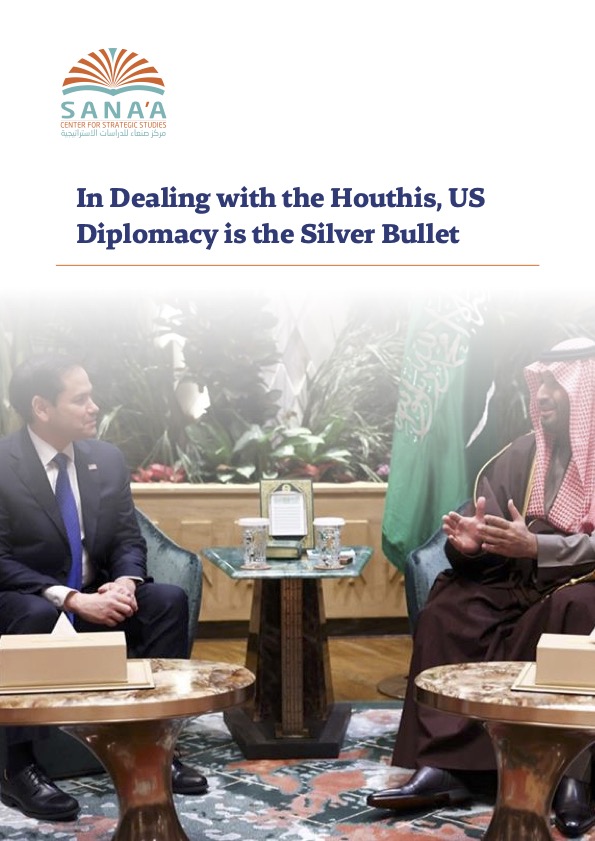Ever since the Houthis started disrupting commercial marine traffic through the Red Sea in late 2023, calls for the use of force have been sounded from every corner of the anti-Houthi camp. The Yemeni government has advocated for international military action, while UAE-sponsored armed groups have hinted at their willingness to spearhead an international offensive against the Houthis.
Clearly, none of these parties learned the lessons of Iraq and Afghanistan. Civil wars are not settled by foreign intervention. At best, foreign forces can tip the balance in favor of their domestic allies, but more often than not, they merely prolong the conflict, fuel the war economy, exacerbate the bloodshed, and then withdraw in a hurry, leaving local partners to their fate.
There was a time when the Houthis could have been defeated: in mid-2017, when pro-government forces reached the village of Mahalli, 23 kilometers from Sana’a airport, but the Saudi-led coalition forced them to withdraw. Eight years later, with the Houthis in firm control over most of the North, encircling Marib, and threatening to make inroads into the South, it is difficult to imagine their total defeat.
The two prerequisites for a successful offensive against the Houthis are unity of leadership and effective institutional capacity. As it stands, the ability to plan, deploy, and supply forces for such an offensive is simply not present. A more realistic objective is for pro-government forces to plan for the defense of their current positions and prove to be a credible deterrent to Houthi aspirations of extending their control over the rest of Yemen. Facing that reality on top of serious economic difficulties, the Houthis would have no choice but to negotiate an end to the conflict based on power sharing and the formation of a government of national unity. That government would then become the check on Houthi excesses and adventures outside Yemen’s borders.
In the past month, the US has been bombing Houthi military positions. However, experts believe that Houthi military readiness is still superior to that of their domestic opponents, even with air support from the US. Therefore, the unrealistic expectations that the US will change the balance of power between the Houthis and the government overlook the limits of US objectives, including the desire for a quick win. US President Donald Trump, after all, does not want to tarnish his brand of ending the “Forever Wars.” US commanders have also raised the alarm that the Yemen campaign will drain ammunition needed to deter China. In reality, a military offensive on the ground could lead to significant setbacks for the government if the US suddenly withdraws its support due to other developments in the region. If pro-government forces are defeated, regional and international actors are likely to make a deal with the Houthis, leaving the government out in the cold.
The objective of defeating the Houthis outright is both unrealistic and counterproductive. It is important to remember that there are militant religious ideologues on both sides of the conflict. The backbone of the armed groups formed by the UAE is comprised of Salafis, who believe that they must wage jihad against the Zaidi Houthis. The forces supported by Saudi Arabia were, until recently, dominated by the Islamist political party Islah and its military wing. The Nation’s Shield forces, established by Saudi Arabia in September 2022 under the overall command of President Rashad al-Alimi, also consist primarily of Salafi troops. The defeat of one side will only bring another group of fanatics to the forefront. Moreover, the unlikely scenario of outright victory of either side will inevitably lead to the further disintegration of the Yemeni state. If the Houthis win, the South would likely secede, and parts of the North, such as Taiz and Marib, would pursue every avenue to remain free from Houthi control. If the government wins, the Houthis are still unlikely to surrender and would likely maintain enclaves outside government control. Disintegration would also give Al-Qaeda and Islamic State jihadists a golden opportunity to expand their control and turn Yemen into a haven for militants from all over the world. Ultimately, Yemen’s best chance to restore stability is to have a durable balance of military power between the two sides, or the many sides, of the Yemen conflict. This must be accompanied by a high degree of autonomy for the governorates during a prolonged transitional period. State institutions could, in the meantime, develop the capacity to reestablish centralization.
So what can the US do to achieve that outcome? US Congressman Joe Wilson said it best: “Saudi Arabia is a close and constructive partner and a great friend against the Iranian regime. We need to work together with Saudi and UAE to unify the Yemeni military to defeat the Houthis.” Many pro-government commanders have told the Sana’a Center they have enough material assets for a successful defensive strategy. Their weak point is the fragmentation of command, while the main dividing line is loyalty to Saudi Arabia or the UAE. While Yemeni factions can do much to secure the defense of their positions, their regional backers can only do so much to help them. Only the US has the leverage to push the two sponsors to unify the command of pro-government forces. That is the silver bullet to bring peace to Yemen.
This commentary is part of a series of publications produced by the Sana’a Center and funded by the government of the Kingdom of the Netherlands. The series explores issues within economic, political, and environmental themes, aiming to inform discussion and policymaking related to Yemen that foster sustainable peace. Any views expressed within should not be construed as representing the Sana’a Center or the Dutch government.

 اقرأ المحتوى باللغة العربية
اقرأ المحتوى باللغة العربية
